
Understanding dropshipping and steps to launch your own online business


As a dropshipper, you spend a lot of time and resources bringing new customers to your site. SEO, social media, and other channels add up quickly. However, even if your marketing brings lots of new users to your site, you might not see much of an increase in sales. If this is the case, your dropshipping site could have a cart abandonment problem.
Abandoned cart recovery is crucial for reducing lost sales by utilizing apps and automated email campaigns to send reminders and offers, enticing customers to return and complete their purchases on Shopify.
In this guide, you’ll learn everything you need to know about reducing abandoned carts on Shopify:
A shopping cart is abandoned when an online shopper adds a product to their cart and then leaves the website without making a purchase. Cart abandonment is different from checkout abandonment, which occurs when customers leave during the checkout process, often due to being asked to create an account. Both are problems for Shopify sites, but abandoned carts are particularly painful because the shopper is much closer to actually buying something.
Calculate your site’s cart abandonment rate by subtracting the number of completed sales from the number of total carts created. Divide that number by the number of total created carts.
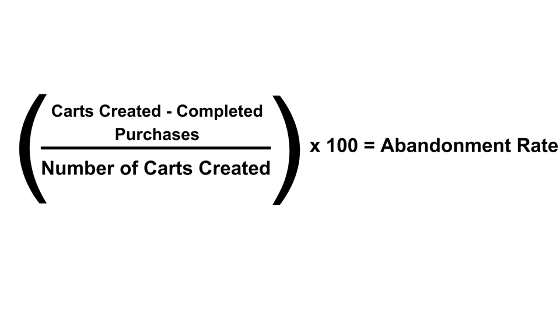
For example, take a Shopify store with 1000 total carts created and 400 completed transactions. 1000 carts minus 400 sales is 600 abandoned carts. 600 divided by 1000 carts is 0.6. Multiply by 100 and you get a cart abandonment rate of 60%.
According to the Baymard Institute, a user experience market research firm, the average cart abandonment rate is 70.19% in 2024. Furthermore, a study by Statista found that 25% of shoppers abandon a cart and go on to purchase from a competitor.
Abandoned checkout also significantly impacts revenue. Unlike abandoned carts, which occur when items are left in the cart, abandoned checkouts happen when customers leave during the checkout process. Managing and recovering abandoned checkouts through automated reengagement emails and understanding the automation workflow can help recover lost sales.
To put a dollar amount on it, consider this scenario:
Your website has an overall conversion rate of 1% and brings in 100,000 visitors each month with an average transaction value of $100. Your visitors currently complete 1,000 transactions per month and generate $100,000 in revenue.
If you can recapture half of those abandoned carts, you can bring in an additional $50,000 in revenue each month.
Add it all up and you can easily see why reducing the cart abandonment rate is an effective tactic for ecommerce conversion optimization.
To fully understand your website’s ecommerce performance, you need to track your cart abandonment. There are a few ways you can do this.
In addition to abandoned carts, tracking abandoned checkouts is crucial. This helps you access, review, analyze, and recover unfinished customer orders within the Shopify admin, and explore strategies to reduce cart abandonment.
For Google Analytics 4 users, follow Google’s Checkout Journey Report, or watch this video guide on YouTube.
You can also calculate your site’s abandonment rate through your Shopify analytics dashboard. Open the Online Store Conversion Rate report and look at “Added to cart” sessions and “Sessions converted.” These are your total number of carts created and total number of sales, respectively.
Simply plug these numbers into the formula from the previous section to get your store’s cart abandonment rate.
Struggling with abandoned carts for your ecommerce site or looking to increase your Shopify sales? These 10 strategies will reduce cart abandonment and help bring customers back to your site to finish their purchase.
One effective approach is to recover abandoned carts, which can significantly reduce lost sales and boost your profits.
Since 23% of cart abandoners do so in response to a complicated checkout process, simplifying it can significantly reduce cart abandonment. Benchmark studies have found most online checkout forms don’t need more than 14 elements, including buttons and drop-downs. However, websites have an average of nearly 24 elements in their checkout forms.
Make checkout easier by creating fields just for the information you need to complete the transaction. The example below shows what an optimized shipping form could look like.
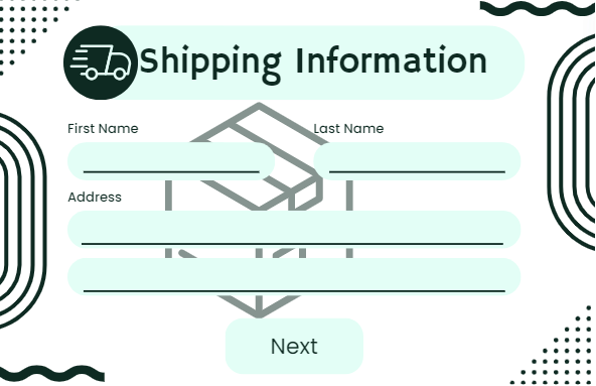
Offering multiple payment options, such as credit cards, digital wallets, and cash on delivery, can also reduce cart abandonment by meeting diverse customer preferences and expediting the payment process.
Enable Shop Pay to make checkout effortless. Shop Pay saves users’ details so they can skip the payment and shipping steps.
To activate Shop Pay,
Allow guest checkout to further improve the checkout process. Plus, account requirements cause 26% of abandoned carts.
Enable guest checkout in your Shopify site’s Checkout settings. In the customer accounts section, click the button for either “Don’t use accounts” or “Accounts are optional”. Customers can now buy products without an account.
For more details on this topic, feel free to check out our post on how to optimize your dropshipping checkout process!
Unexpected fees, such as shipping, are responsible for nearly half of all abandoned shopping carts. A free shipping option will go a long way toward reducing cart abandonment.
However, free shipping can be a big ask for new or smaller stores and might not be viable for the entire inventory. If this is the case, offer free shipping for orders over a certain amount. Radio equipment company Cobra, for example, offers free shipping on orders of $80 or more.
If free shipping isn’t a possibility at all, be transparent about shipping fees throughout the checkout process.
Add estimated shipping costs to your cart before users start checking out. If you have flat-rate shipping, you can simply add this to your checkout process yourself. A Shopify app such as Shipping Rates Calculator Plus will integrate estimated shipping costs into your shopping cart.
Exit intent pop-ups are widgets displayed when a browser detects the user’s cursor moving toward the browser’s exit button. Seeing that almost half of all abandoned carts are left because users aren’t convinced they want to buy the product, these pop-ups can be an incredibly effective strategy to capture more conversions.
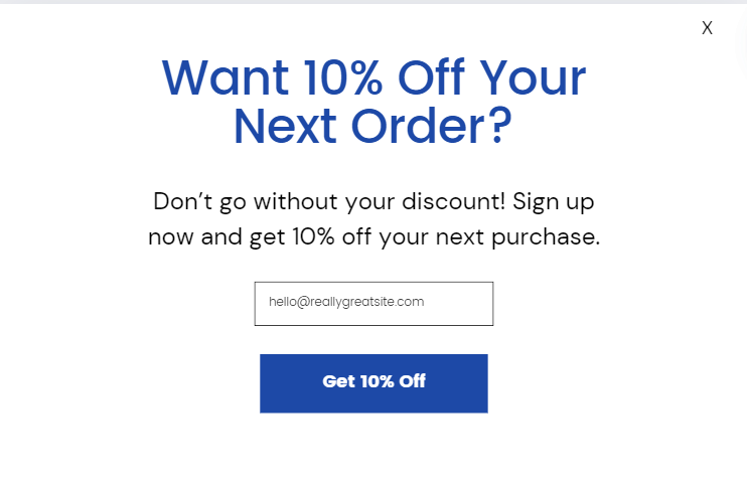
A website could use a pop-up like the image above to entice shoppers to sign up before they abandon their cart. Getting users to take an action, along with the discount, makes them more likely to complete their transaction.
Use exit pop-ups to deliver last-ditch content to push the sale over the line:
According to Venture Harbour, exit pop-ups can increase conversion rates by 5–10%. It’s not huge, but it’s something and can quickly add up.
You can use the following Shopify apps to create pop-ups for your site:
Email is one of the most effective channels for re-engaging your customers, and abandoned cart recovery is crucial for recapturing lost sales. Many ecommerce websites use an abandoned cart email strategy to remind shoppers they have items waiting or to offer enticing discounts.
A typical abandonment email flow could look something like this:
You might find different timing works better than the suggestion above. However, always send the first email within 24 hours. According to AdRoll, emails sent more than a day after convert at a rate of 2.6%, compared with 4.5% for emails sent within the first day.
Use these tips to create effective cart abandonment emails:
For email automation tools for cart abandonment emails, check out these Shopify apps:
Rewards programs encourage repeat business. A study published in Harvard Business Review found loyalty programs increase the likelihood of conversion by 6.1%. That same study found that rewards members bought more products and more expensive versions of products they had already purchased. Overall, members’ spending increased by 50% over two years.
As an example, Nordstrom’s Nordy Points program rewards customers with points based on how much they spend. Customers earn Notes when they reach certain point levels. Those notes can be exchanged for discounts on any products sold by Nordstrom.
A program such as this encourages repeat spending and incentivizes large, high-value purchases.
There are two recommended apps to build a rewards program for your Shopify store:
Retargeting advertising finds your shoppers around the web and shows them the products they left in their cart. Since you already know what products your shoppers want to buy, cart abandonment campaigns make for effective retargeting ads for ecommerce. Retargeting ads are crucial to recover Shopify abandoned carts, unlocking potential sales through innovative methods.
In general, retargeted ads have a CTR that’s 10 times higher than regular ads.
Here are some good retargeting ad Shopify apps that will show your ads to users on Google and Facebook:
One of the main reasons shoppers still use brick-and-mortar shops is the customer support experience. They value having a salesperson on hand to provide product information and answer questions.
You obviously can’t have a sales associate to help your customers in person, but you can use a customer support chat to guide them through the checkout process to reduce abandoned carts. According to Statista, more than 75% of sites that use chat report a positive impact on sales.
Put a small button somewhere on your site where it’s visible but still out of the way so users can start a chat to get information on products, shipping, and returns.
If you detect a shopper hesitating on the order confirmation page, automatically trigger a support chat window. Proactive support can offer the information or guidance needed to convince the shopper to complete the transaction.
Shopify apps that enable customer support include:
Push notifications display messages directly on the user’s device screen. It’s nearly impossible for someone not to notice a push notification, and these notifications typically require some sort of interaction to close.
A Shopify abandoned cart app can help merchants recover lost sales by sending recovery messages through various channels like email, SMS, and web push notifications. These apps often include features such as Facebook messaging, exit-intent popups, and real-time tracking of abandoned carts within the Shopify platform.
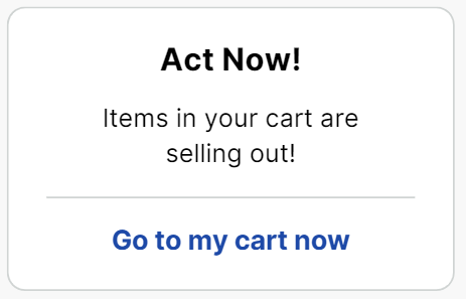
Using push notifications to create a sense of urgency is an effective tactic. A good way to create urgency is to emphasize an item’s limited availability, like the example above, or expiring offer.
According to MESA, one company used push notifications to recover $123,279 in abandoned carts.
Good Shopify apps for push notifications are:
Don’t think the mobile shopping experience matters for your site? Consider the following statistics:
For mobile optimization, choose a responsive Shopify theme. Your site will looks great no matter the user’s device. Responsive themes change image and font size, page layout, and page content based on screen size.
You also need to focus on speed for mobile users. Optimize your site’s images by compressing image files. You’ll reduce size without affecting quality. JPEG files offer the best balance between size and quality for images.
Your checkout experience is another area to optimize for mobile users. Obviously, your checkout pages need to load quickly on mobile. Make payments faster and easier for mobile users by enabling Apple Pay and Google Pay in your store.
You should also make sure forms are easy to navigate and fill out. Enable address autocompletion in your Spotify settings.
Tools for Spotify mobile optimization include:
Personalizing your Shopify store can make up to 80% of shoppers more likely to complete a sale on your site. According to Shopify, recommended products have high conversion rates and margins. You can increase sales by using personalization before and after cart abandonment.
Shopify abandoned cart apps play a crucial role in this process by sending automated messages to remind customers to complete their purchase, tracking abandoned carts in real time, and ultimately recovering lost sales.
Customize your shopping carts based on a user’s browsing history to display a “previously viewed” section. You can also recommend other relevant or complementary products. As a hypothetical, the product page for a face moisturizer can include recommendations for serums, face washes, and toners.
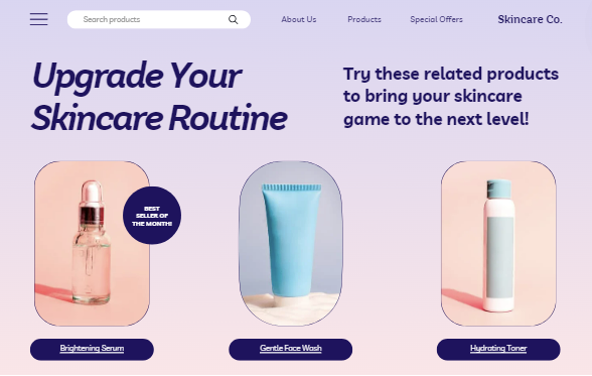
Amazon is perhaps the most famous example of personalization. Its product pages and shopping carts include multiple sections for recommendations based on related products, previous browsing, and past purchases.
Continuous shopping is another on-site personalization tactic to reduce abandoned carts. When a shopper returns to your site, show the product they were considering and let them continue the checkout process where they left off. Users are more likely to convert when they don’t have to start over from the beginning.
Dynamic retargeting is an advanced tactic that creates ads on what you know about your shoppers. Rather than just showing previously viewed products, as with other forms of retargeting, dynamic ads show different content based on what’s most relevant to them.
These ads are dynamic because the content will change each time a customer browses new products on your site.
Most major ad networks make dynamic retargeting easy by letting you import your Shopify product feed to the ad platform.
Tools for personalization on Shopify include:
When you have successfully recaptured your shoppers to convert abandoned carts, the next step is to deliver quality service to retain these valuable customers. Tradelle will help you automate your Shopify store. Import your products from Tradelle into Shopify and when a customer completes a translation, Tradelle will automatically ship their item and keep the customer informed with shipping updates. Start your 7-day free trial now.
Simplify the checkout process, offer multiple payment options, and clarify shipping charges upfront.
Use Shopify apps like Klaviyo or Omnisend to automate and personalize cart abandonment emails.
Recommended apps include MESA, Klaviyo, Kit Karts, and Omnisend for email campaigns, and PushOwl for push notifications.
Common reasons include complicated checkout processes, unexpected shipping fees, and account creation requirements.
Use cart abandonment email campaigns, exit pop-ups, and retargeting ads to re-engage customers.
Now, what have we learned? Reducing cart abandonment is crucial for maximizing sales and improving the overall performance of your Shopify store. By simplifying the checkout process, offering multiple payment options, and being transparent about shipping charges, you can significantly decrease the number of abandoned carts. You can use cart abandonment email campaigns, exit pop-ups, and retargeting ads which will help re-engage customers and recover lost sales as well. Try some of the strategies mentioned, and see what it can do for you!


Understanding dropshipping and steps to launch your own online business

Discover top strategies to identify high-demand, profitable products on AliExpress

Learn about strategies that drive traffic to your store, including effective advertising practices

Learn about several proven methods to increase your store sales
Imagine someone asks you who your supplier is, and then you have to tell them it’s a private agent, or AliExpress, or an automation tool that simply buys from AliExpress for you. It’s 2025. Your customers, your revenues, and your profits will thank you.
Get started for free
You need to load content from reCAPTCHA to submit the form. Please note that doing so will share data with third-party providers.
More InformationYou are currently viewing a placeholder content from Turnstile. To access the actual content, click the button below. Please note that doing so will share data with third-party providers.
More InformationYou are currently viewing a placeholder content from Facebook. To access the actual content, click the button below. Please note that doing so will share data with third-party providers.
More Information